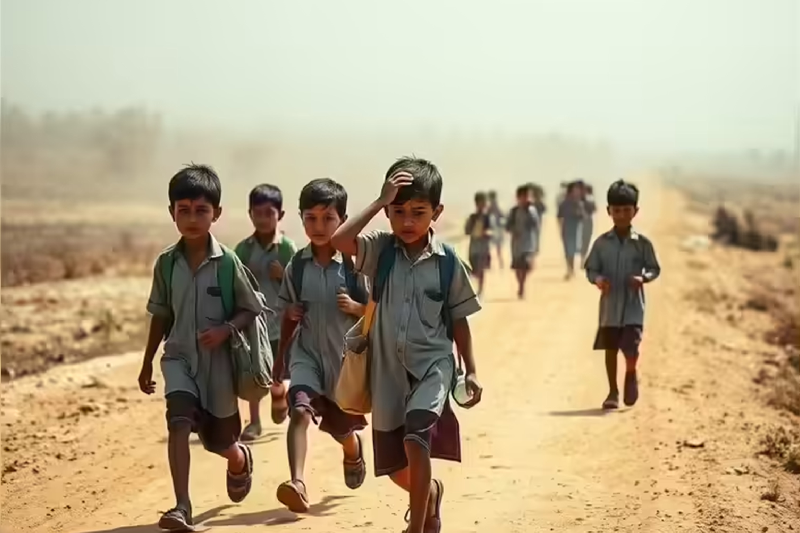
Children Exposed to Heat Waves May Lose Up to 1.5 Years of Schooling, Warns UNESCO
Climate change is not just a looming environmental crisis but also an urgent educational challenge. According to a new report by UNESCO, children exposed early in life to extreme heat and other climate-related disasters may lose up to 1.5 years of schooling. The findings highlight how climate stressors are threatening to undo decades of educational progress, especially in low- and middle-income countries.
How Climate Change Affects Education
UNESCO’s report draws a direct link between climate-related stressors and adverse educational outcomes. These stressors include:
- Heat waves and rising temperatures
- Wildfires
- Storms and floods
- Droughts
- Spread of diseases
- Rising sea levels
In many vulnerable regions, these events lead to frequent school closures, disrupting learning and increasing dropout rates. The report emphasizes that most low- and middle-income countries are experiencing climate-induced interruptions to education every year.
The Scale of School Closures Due to Extreme Weather
Data compiled by UNESCO’s Global Education Monitoring (GEM) team and the Monitoring and Evaluating Climate Communication and Education (MECCE) project, along with researchers from the University of Saskatchewan, Canada, paints a stark picture:
- Over the last 20 years, schools were closed in at least 75% of extreme weather events.
- These closures affected over five million people per event on average.
Such frequent disruptions are creating significant learning losses, especially for children in vulnerable communities.
Impact of Heat on Schooling: Global and Regional Findings
Exposure to high temperatures, particularly during prenatal stages and early childhood, has shown significant negative effects on educational attainment. The report’s key findings include:
- Children experiencing temperatures two standard deviations above the average tend to complete 1.5 fewer years of schooling compared to those in average climates.
- In Southeast Asia, high temperatures correlate strongly with fewer years of schooling.
- In China, heat exposure reduced performance on high-stakes tests and lowered both high school graduation and college entrance rates.
- In the United States, schools without air conditioning saw test scores decline by 1% for each 1°C rise in temperature during the school year.
These effects highlight how extreme heat can impair cognitive functions, reduce concentration, and negatively impact student performance.
Unequal Impact on Marginalized Communities
The report stresses that climate-induced educational setbacks disproportionately affect marginalized and disadvantaged groups:
- In the U.S., African American and Hispanic students suffered greater educational losses on hot days, largely due to poor infrastructure such as lack of air conditioning. This contributed to about 5% of the racial achievement gap.
- About half of public school districts globally need to upgrade their heating, ventilation, and air conditioning (HVAC) systems to cope with rising temperatures.
- In Brazil’s most disadvantaged municipalities, students lost about 1% of learning per year due to rising heat risks.
This uneven impact exacerbates existing educational inequalities and vulnerabilities.
Climate Risks and Vulnerability of Fragile States
UNESCO’s report identifies that:
- Eight of the ten countries most affected by extreme weather in 2019 were low- or lower-middle-income countries.
- Out of 33 countries with extremely high climate risks for children, 29 are fragile states, already burdened with governance and development challenges.
- Nearly 1 billion people live in these high-risk countries, facing compounded challenges of climate and educational vulnerability.
In such fragile contexts, children’s education is at heightened risk due to the combined effects of environmental disasters and systemic socio-economic issues.
Health Implications Linked to Climate and Education
Beyond direct heat effects, climate change influences health outcomes that also affect schooling:
- In the United States, children from low-income families or without secondary education are 15% more likely to live in areas with increased childhood asthma diagnoses due to particulate air pollution linked to climate change.
- These health issues further hinder school attendance and learning capacity.
Disaster Preparedness and School Resilience
The report also highlights the role of school disaster management plans in mitigating educational disruption during extreme weather events:
- For example, after the 2013 floods in Jakarta, schools were used as emergency shelters and many were temporarily closed due to damage.
- However, 81% of schools with established disaster management plans and standard operating procedures for flood emergencies reported these measures as effective during the crisis.
Such preparedness helps maintain educational continuity and safeguard students and staff during climate-induced disasters.
The Urgent Need for Climate-Resilient Education Systems
Given the increasing frequency and intensity of climate events, the report calls for urgent action to build climate-resilient education systems worldwide. Key recommendations include:
- Investing in infrastructure upgrades, such as HVAC systems, to protect students from extreme heat.
- Integrating climate education into curricula to prepare children for future environmental challenges.
- Establishing and strengthening disaster management protocols at schools to reduce learning disruptions.
- Prioritizing vulnerable and marginalized communities in climate adaptation and education funding.
Failure to address these needs risks reversing hard-earned gains in global education.
Conclusion: Climate Change and Education—A Dual Crisis
UNESCO’s report makes it clear that climate change is not only an environmental emergency but a profound threat to children’s right to education. The loss of up to 1.5 years of schooling for children exposed to extreme heat underlines how deeply climate stressors undermine educational progress.
For policymakers, educators, and international stakeholders, the message is urgent: building climate-resilient, inclusive education systems must be a priority. Only then can the world safeguard the futures of millions of children and continue the march toward global education goals despite a changing climate.



